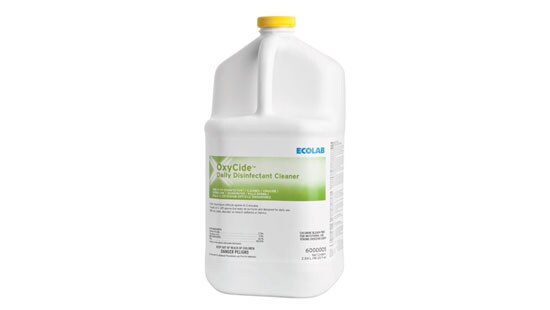
OxyCide™
Daily Disinfectant Cleaner
OxyCide™ Daily Disinfectant Cleaner is a one-step disinfectant for use in hospitals that is effective against Clostridioides difficile (formerly Clostridium difficile) spores, Candida auris and a broad spectrum of other organisms. Its non-bleach formula is compatible with a wide range of materials and helps standardize and simplify your cleaning process for improved operational efficiency.
Features and Benefits
- Disinfectant cleaner, virucide and deodorizer with sporicidal activity for hard and flexible non-porous inanimate surfaces
- Peracetic acid and hydrogen peroxide chemistry
- Designed for daily cleaning, discharges and isolation Kills Candida auris in 3 minutes*
- Kills Clostridioides difficile and 32 other organisms in 5 minutes or less
- One-step no rinse process that eliminates need for general disinfectant, disinfectant with sporicidal activity, toilet bowl, glass and stainless steel cleaners
- Favorable material compatibility that helps minimize damage to surfaces
- Does not leave residual salts or films behind One dilution rate (3 oz/gal) Closed loop package and dispensing system with enhanced safety features EPA Reg. No. 1677-237
*This claim has been approved by the federal EPA and is currently being reviewed by the state agencies, including California Department of Pesticide Regulation (CDPR)
| Metals | Plastics | Floor/Fixtures | Fabric/ Upholstery | Elastomers |
|---|---|---|---|---|
| 304 SS | ABS | Floor Finish | Polyester | Nitrile |
| 316 SS | HDPE | Granite | Nylon | Polyethylene |
| Nickel | LDPE | Epoxy Grout | Cotton | Viton |
| Chrome | PET | Glazed Ceramic | Microfiber | Silicone |
| Polycarbonate | Glazed Porcelain | Vinyl | EPDM | |
| Acrylic | Porcelain Enamel | Polyurethane | ||
| Polypropylene | Glass | |||
| Polysulfone | Formica | |||
| Polystyrene | Melamine | |||
| PVC | Laminate | |||
| Painted Surfaces |
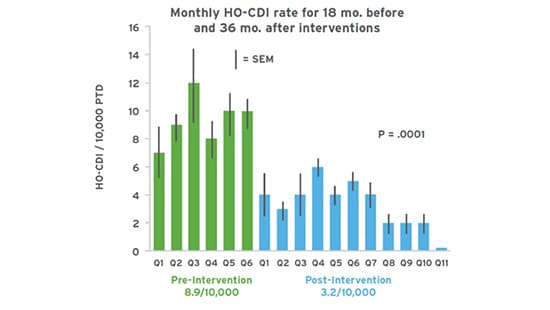
Study Shows Proven Results
Beaufort Memorial Hospital reduced Hospital-Onset C. diff rates by 64%, improved high-touch object cleaning to >88%, reduced damage to hospital equipment, and improved room discharge time by 9 minutes as part of an overall environmental hygiene program implementing training and monitoring and use of OxyCide™.

Impact of OxyCide™ Use on Environmental Contamination and Infection Rates Compared to Standard Cleaning Practice
OxyCide™ was associated with decreased infection rates when compared to standard cleaning with quat and bleach.
“OxyCide™ enabled standardization of cleaning procedures across all units and departments, making cleaning and disinfecting simple and straightforward.”
– C. Chagai, Director of Hospitality Services in Clinton, IA (2019)
In a study that compared bleach to OxyCide™:
“EVS staff stated that patients preferred the smell of the current room cleaner (OxyCide™) compared to bleach used previously.”
– Infection Control & Hospital Epidemiology (2019), 40, 880-888

Can UV Disinfection Replace Manual Cleaning?
UV disinfecting systems are good supplements to manual environmental cleaning, but do not replace it. In addition, UV systems cannot be used when the patient is in the room, preventing daily use. However, the cleaning efficiencies and room turnover time savings gained through OxyCide™ Daily Disinfectant Cleaner enable EVS teams to deploy UV systems for supplemental disinfection.

OxyCide™ Safety Data
When diluted according to label instructions, personal protective equipment (PPE) is not required.
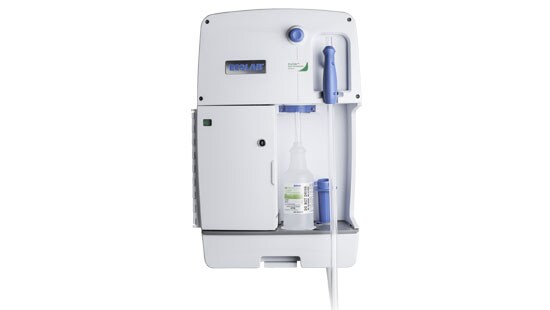
OxyCide™ Dilution Management System
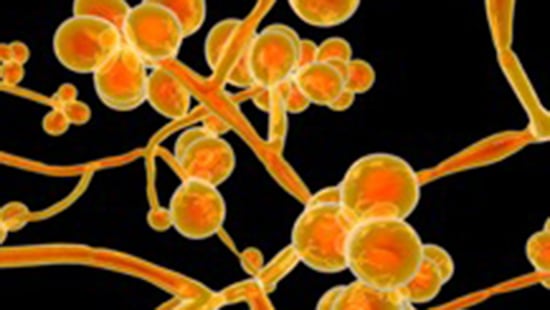
What is Candida auris?
According to the CDC, C. auris is an emerging fungus that presents a serious global health threat. It is multi-drug resistant, difficult to identify and can spread through sick patients as well as on contaminated surfaces and equipment, putting hospitalized patients and hospital systems at risk for outbreaks.
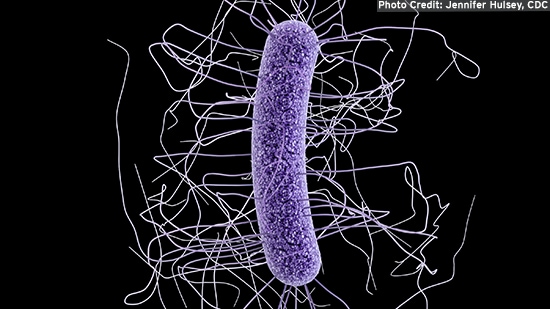
What is Clostridium difficile?
It is a bacteria that has developed resistance to most commonly used antibiotics. When exposed to air it forms a spore that allows it to remain in the environment for long periods of time. It causes diarrhea and more serious intestinal conditions such as colitis. It is the most frequently identified cause of hospital-acquired diarrheal infection.

1/2 Million Illnesses Each Year Caused by C. difficile
The United States Center for Disease Control and Prevention (CDC) in collaboration with state health departments estimate that C. difficile causes almost half a million illnesses each year in the U.S. resulting in 29,300 deaths. About one quarter of these illnesses occurred in hospital settings.


